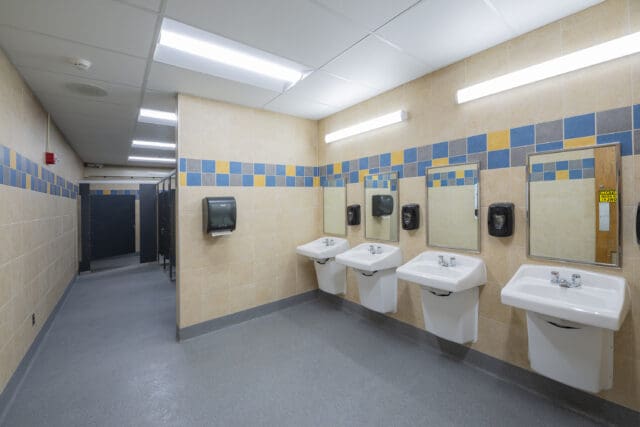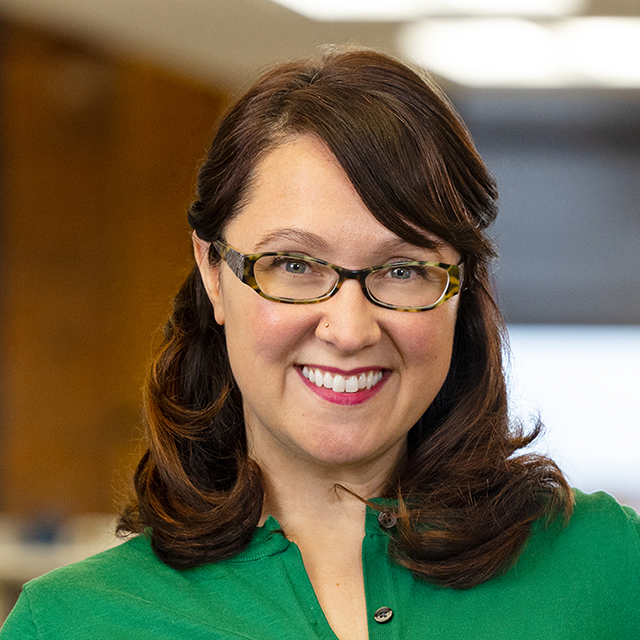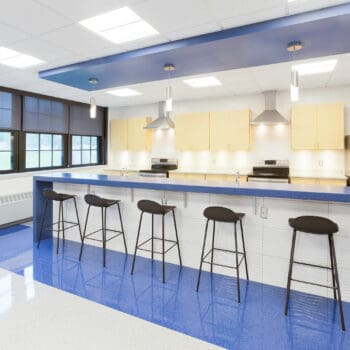Rethinking K-12 Bathroom Design

Designing bathroom facilities in K-12 schools may seem straightforward, but these spaces require a thoughtful balance of elements that provide privacy for the user, durability for the facilities team, and safety and security for the school community.
 In this interview, we spoke with Courtney Ter-Velde, a NYS Certified Interior Designer and Accredited Learning Environment Planner, about how LaBella’s team approaches K-12 bathroom design to provide safe spaces that meet the needs of students, staff, and administrators.
In this interview, we spoke with Courtney Ter-Velde, a NYS Certified Interior Designer and Accredited Learning Environment Planner, about how LaBella’s team approaches K-12 bathroom design to provide safe spaces that meet the needs of students, staff, and administrators.
How often do we design bathrooms in K-12 schools?
Within the last five years, we’ve seen an increase in the demand for bathroom designs. In older buildings that require renovations, the age of the facility and compliance with the Americans with Disabilities Act (ADA) are often driving factors.
Beyond designing or upgrading to meet regulatory requirements, many schools are looking to address other challenges that traditional, multi-user bathrooms present, particularly around safety and vandalism.
What are some bathroom design challenges you’re facing today?
A topic we often discuss from a facility and administrative lens is the challenge of vandalism and illicit activity. The traditional multi-stall design creates opportunities for incidents to occur behind closed doors where observation is limited. For example, one high school project currently under construction was fast-tracked because students were attempting social media challenges that encouraged acts of vandalism, such as ripping sinks off the walls and flushing large amounts of paper products down the toilets.
The cost and effort required to repair the damage forced the school to shut down the bathroom so it could be properly cleaned and cleared. From an observation standpoint, it became critical for the district to modify the facility to prevent the damage from happening again.
To balance students’ need for privacy and the school’s need for observation, we designed individual-use bathrooms arranged along three walls in a U-shape within a larger space. The waiting area opens to the corridor through a set of double doors held in place by magnetic hold-opens, which release and close in an emergency.
Security cameras observe the corridor to better identify individual comings and goings. There’s no observation within the actual toilet rooms, but the smaller footprint of each individual room prevents multiple people from occupying a single stall, making it easier to identify if damage is being caused. Individual-use toilet rooms are also often equipped with sensors that can detect illicit activities, such as smoking or vaping.
Are individual-use bathrooms a common design request?
Yes, for students who are already navigating an emotionally and socially challenging time, entering a traditional multi-stall bathroom can create fear or anxiety, which may trigger behavioral issues or absenteeism. Since it’s not feasible to have a monitor in every restroom, designing facilities that help students feel safe and comfortable is preferred.
One way we address these needs is by incorporating multiple types of facilities to meet different needs. Individual-use bathrooms provide an accessible option for students who may not feel comfortable being in a facility with their peers. We’ve seen an increase in requests for this type of design from districts as well.
What materials, fixtures, and layouts do you recommend to support hygiene in high-traffic school environments?
Durability and cleanability are critical, as bathrooms are one of the most highly trafficked spaces in a school. Part of our design evaluation involves working with facilities directors to understand their maintenance programs and determine how the materials and fixtures we propose can be incorporated into their program. Staff training and access to appropriate equipment are also considered to ensure the facility can be maintained successfully.
 We’ve seen growing interest in removing grout and tile flooring systems to reduce the amount of scrubbing required to clean away dirt and bacteria. In place of tile, we’re installing epoxy resinous flooring systems, which are monolithic, seamless surfaces that can include an aggregate for slip resistance. Because of the seamless application, the flooring can wrap up the wall to create an integral base, so the area can be hosed down with water that’s directed to a floor drain.
We’ve seen growing interest in removing grout and tile flooring systems to reduce the amount of scrubbing required to clean away dirt and bacteria. In place of tile, we’re installing epoxy resinous flooring systems, which are monolithic, seamless surfaces that can include an aggregate for slip resistance. Because of the seamless application, the flooring can wrap up the wall to create an integral base, so the area can be hosed down with water that’s directed to a floor drain.
Another recommendation we make to assist with cleanability is using high-density polyethylene (HDPE) partitions between the toilets. HDPE is a highly durable, moisture-resistant plastic that’s denser than standard partitions and has a very high wear rating.
Touchless features—like motion-sensored toilets, faucets, soap dispensers, and hand dryers—reduce waste and the amount of daily cleaning and disinfection required.
Standard materials can also be adapted for bathroom use, such as ceiling tiles that can be bleached and cleaned and epoxy paints that withstand frequent scrubbing better than standard latex paint.
How do we deal with footprint limitations during design renovations?
Anytime the configuration of an outdated facility is modified, it must be upgraded to meet ADA standards. Balancing the International Building Code (IBC), which establishes fixture counts based on building occupancy, with ADA compliance can present a challenge for schools with space constraints.
The space needed to add an ADA-compliant facility can reduce the total fixture count required by the IBC. When a school is considering a program change or the district is developing a master plan, we identify the need for additional facilities during that process.
If a school already has more than the IBC-required number of fixtures, it’s much easier to add an ADA-accessible toilet room. If space does not allow conversion from multi-stall to individual toilet rooms, a renovation to make the existing space ADA-compliant would likely occur.
There’s also an opportunity to evaluate nearby rooms for potential conversion to individual-use bathrooms.
How do you tailor bathroom designs across different grade levels?
Most of our discussion has focused on middle and high school. For pre-K, kindergarten, and first grade, most states require bathrooms within the classroom so staff can provide assistance when necessary. For the remaining elementary school grades, multi-stall facilities are the most common. Designing sinks to face the corridor helps ensure handwashing can be observed. In both in-classroom and multi-stall elementary bathrooms, most fixtures are smaller than standard and installed at lower heights to accommodate younger students.
There’s no one-size-fits-all solution to such a complex topic. Finding the right balance between privacy, safety, and security in K-12 bathrooms is an ongoing effort. By offering both multi-user and individual-use facilities, and by carefully selecting materials and layouts that support maintenance and student well-being, schools can provide students with options that help them feel comfortable and secure in what can be a vulnerable environment.

About the Author
Courtney Ter-Velde, CID, ALEP, LEED GA, IIDASenior Interior Designer
Insights by Courtney Ter-Velde, CID, ALEP, LEED GA, IIDA:
As a NYS Certified Interior Designer, Courtney has over 10 years of experience in commercial interior design, with a focus in educational planning and K-12 design (Master Planning, CIP, COEP, and SED). Courtney’s expertise in educational and K-12 design includes programming, space planning, standardization, visualization, and the ability to customize and tailor each district’s needs through evidence-based design for social and emotional learning and student exploration. She is passionate about creating future-forward learning environments that stimulate students and educators alike.

